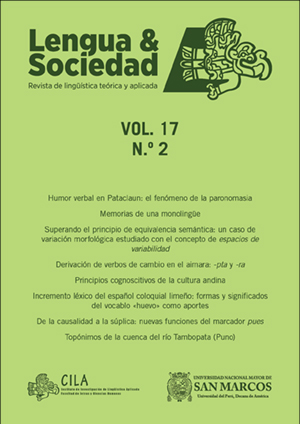Verbal humour in Pataclaun: the phenomenon of paronomasy
DOI:
https://doi.org/10.15381/lengsoc.v17i2.22350Keywords:
Verbal humour, linguistic game, paronomasia, polysemy, homonymyAbstract
The article contains a compilation of some dialogues presented in the Pataclaun program (1997-1999) that allow the visualization and explanation of the phenomenon of paronomasia, defined by López (2005) as a language game that involves linguistic phenomena such as polysemy, homonymy and resegmentation. Paronomasia is configured through various linguistic phenomena, such as polysemy and homonymy. From the above, the article concludes that paronomasia is an applicable concept for a study of the characteristics of verbal humor in the Pataclaun program.
References
Alvarez, J. (2009). Diccionario de peruanismos. El habla castellana del Perú. Recuperado de http://repositorio.uap.edu.pe/bitstream/uap/4112/1/diccionario_de_peruanismos.pdf
Andreína, M. (2012). Polisemia regular y representación lexicográfica: los nombres locativos en español. Articles, 5, 34-38. Recuperado de https://www.raco.cat/index.php/Terminalia/article/viewFile/257904/345152
Attardo, S. (2001). Humorous Texts: A Semantic and Pragmatic Analysis. Berlín: Mouton de Gruyte.
Cuenca, M., & Hilferty, J. (2013). Introducción a la lingüística cognitiva. España: Ariel.
Escandell, M. (2007). Apuntes de Semántica léxica. España: UNED.
Jiménez, N. (2016). La Teoría General del Humor Verbal en The breif wondrous life of Oscar Wao y La breve y maravillosa vida de Oscar Wao. Verbum et Lingua, 8.
Llera, J. (2004). La investigación en torno al humor verbal. La teoría frente a la hidra humorística. Revista de literatura, 66(132), 527-535. Recuperado de: http://revistadeliteratura.revistas.csic.es/index.php/revistadeliteratura/article/download/132/143
López, M. (2005). La paronomasia como recurso conceptual, expresivo y humorístico en la lengua española actual (Tesis doctoral). Universidad de Granada, Granada. Recuperado de https://hera.ugr.es/tesisugr/15512149.pdf
Luque Durán J. D. (2007). Los juegos lingüísticos: fallos comunicacionales, humorismo verbal y reflexión metalingüística. Léxico español actual: Actas del I Congreso internacional de léxico español actual, 91-126.
Naters, J. (Productor). (1997-1999). Pataclaun [Serie de televisión]. Lima- Perú: Asociación cultural Pataclaun, Frecuencia Latina.
Pérez, J. y Merino, M. (2009). Definición de jerga. Recuperado de https://definicion.de/jerga/
RAE (2019). Diccionario de la Real Academia Española.
Ruiz, L. (2012). La lingüística del humor en español. Madrid: Arco/Libros.
Torres, M. (1997). Teorías lingüísticas del humor verbal. Pragmalingüistíca, 5-6, 435-448. doi: https://doi.org/10.25267/Pragmalinguistica.2017.i25
Ullman, S. (1976). Semántica. Introducción a la ciencia del significado. Madrid: Aguilar.
Valbuena de la Fuente, F. (2002). Humor verbal y humor de situación. Cuadernos de Información y Comunicación, 7, 381-383. Recuperado de: https://revistas.ucm.es/index.php/ciyc/article/view/ciyc0202110381a
Downloads
Published
Issue
Section
License
Copyright (c) 2018 Mariana Mendoza Villanueva, Lucero Paredes Castillo

This work is licensed under a Creative Commons Attribution 4.0 International License.
AUTHORS RETAIN THEIR RIGHTS
a. Authors retain their trade mark rights and patent, and also on any process or procedure described in the article.
b. Authors can submit to the journal Lengua y Sociedad, papers disseminated as pre-print in repositories. This should be made known in the cover letter.
c. Authors retain their right to share, copy, distribute, perform and publicly communicate their article (eg, to place their article in an institutional repository or publish it in a book), with an acknowledgment of its initial publication in the journal Lengua y Sociedad.
d. Authors retain theirs right to make a subsequent publication of their work, to use the article or any part thereof (eg a compilation of his papers, lecture notes, thesis, or a book), always indicating its initial publication in the journal Lengua y Sociedad (the originator of the work, journal, volume, number and date).



























